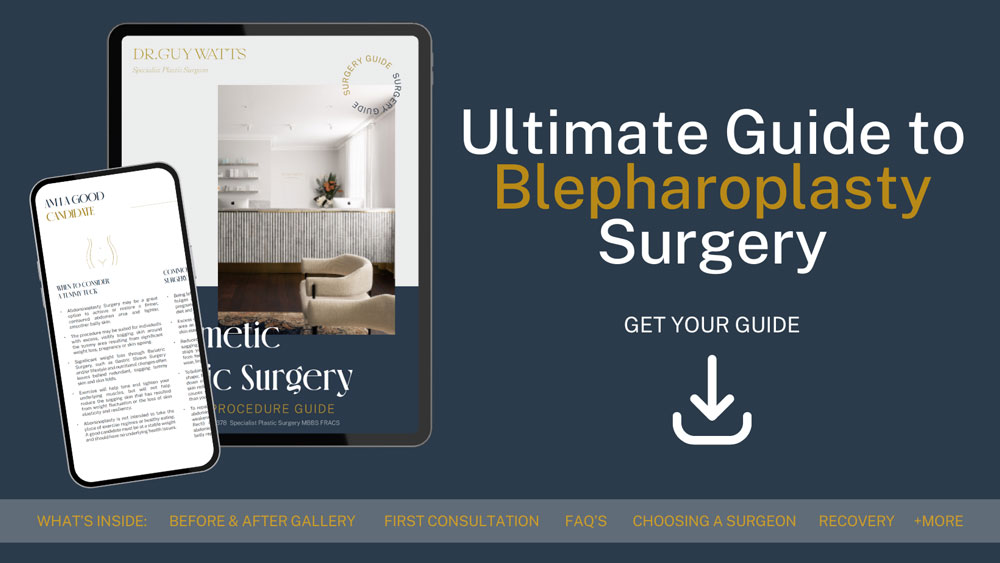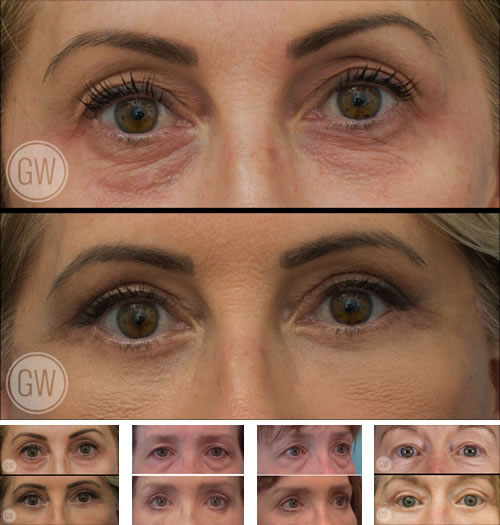This website contains imagery which is only suitable for audiences 18+.

Eyelid Surgery – Blepharoplasty
The eyes are one of the first features people notice about us and play a significant role in expressing our emotions and feelings. However, with age, stress, and other environmental factors, our eyelid skin can lose elasticity, develop wrinkles, or exhibit puffiness, giving a tired appearance or even affecting vision. Eyelid Lift Surgery, also known as blepharoplasty, can help alleviate these concerns, helping individuals achieve their desired appearance.
What Is Blepharoplasty?
Blepharoplasty is a surgical procedure designed to alter the appearance of the eyelids. It can be performed on the upper lids, lower lids, or both. The primary goal of this surgery is to remove excess skin, muscle, and sometimes fat that may be causing skin ptosis (excess skin) above or below the eyes. Whether you’re looking to alter the appearance of your eyes or alleviate functional issue, blepharoplasty may help change the area surrounding your eyes not only aesthetically, but functionally as well.
Download Dr Watts’ Ultimate Guide to Blepharoplasty

Who Is a Good Candidate for Blepharoplasty?
Blepharoplasty is a plastic surgery procedure that can change the appearance of the eyes and increase the field of vision for some. However, not everyone is a suitable candidate for this surgery. Determining suitability involves several physical factors, health conditions, and personal motivations. Here’s a breakdown of what can makes someone a good candidate for Blepharoplasty:
Physical Indications:
- Skin Ptosis: One of the primary reasons individuals seek Blepharoplasty is due to excess skin on the upper eyelids that can lead to obstructed vision.
- Under-Eye Pouching: Puffiness or excess under the eyes, often a result of fat accumulation, can alter a person’s appearance.
- Wrinkles: Fine lines and wrinkles around the eyes, especially on the lower eyelids, can be alleviated with this procedure.
Overall Health: A good candidate should be in general good health. This means:
- No Serious Eye Conditions: Conditions like glaucoma, dry eye, or a detached retina can complicate the procedure. It’s essential to have a thorough eye examination before considering surgery.
- Non-Smokers: Smoking can interfere with the healing process, so non-smokers or those willing to quit before and after the surgery are better candidates.
- No Serious Medical Conditions: Chronic illnesses or conditions that can affect healing might rule out surgery or require additional precautions.
Realistic Expectations: It’s crucial for candidates to have realistic expectations about the outcomes of the surgery. While Blepharoplasty can significantly alter one’s appearance and, in some cases, increase the field of vision, it won’t fundamentally change your facial structure or make you look like a completely different person. A thorough discussion with Dr. Watts can help set achievable goals.
Motivation: The decision to undergo blepharoplasty should be a personal one, made without external pressures. Whether the motivation is cosmetic alteration, functional changes, or both, the candidate should feel comfortable in their choice.
Age Considerations: While there’s no specific age limit for Blepharoplasty, most candidates are typically in their 30s or older when signs of ageing become more pronounced. However, in some cases, young individuals might opt for the procedure due to hereditary factors that cause eyelid ptosis or under-eye concerns at a young age.
REQUEST AN APPOINTMENT
WHAT A BLEPHAROPLASTY MIGHT DO FOR ME?
- Remove excess skin from around the eyes
- Reduce puffiness
- Alleviate the appearance of excess skin on the lower lid
- Increase field of vision by removal of excess eyelid skin
- Alter ‘hooding’ on the upper lid
- Address symmetry of the lids
- Alleviate the appearance of excess skin on the lower lid that exposes the white of the lower eye
- Modify the appearance of the eyes and face
In addition to the surgical procedure, non-surgical techniques such as chemical peels, and other treatments may assist Dr Watts in achieving your desired end result. These can include the management of fine lines and deep wrinkles. Dr Watts will discuss which techniques and processes will most likely achieve your desired results. His Perth-based practice is always happy to receive enquiries and field your questions.
BLEPHAROPLASTY PROCEDURE AND RECOVERY PERIOD
How Is the Surgery Performed?
Blepharoplasty is a delicate procedure that requires precision, experience, and a deep understanding of facial anatomy. The specific techniques and approaches can vary based on the patient’s needs, Dr Watts’ professional opinion and whether the surgery is being performed on the upper eyelids, lower eyelids, or both.
- Pre-Surgical Preparation: Before the surgery, Dr. Watts will conduct a thorough examination of the patient’s eyes and the surrounding area. This includes assessing the amount of excess skin, the distribution of fat and the general health of the eyes. The patient might also undergo vision tests and tear production tests. Photographs may be taken for before-and-after comparisons. It’s essential for patients to disclose their full medical history, including any medications or supplements they are taking, as some can interfere with the surgery or recovery.
- Anaesthesia: Blepharoplasty can be performed under local anaesthesia, sedation, or general anaesthesia, depending on the extent of the surgery and the surgeon’s preference. Local anaesthesia numbs the eyelid area, so the patient feels no pain during the operation. If sedation or general anaesthesia is used, the patient will be asleep or in a deep state of relaxation.
- Incisions: For upper eyelid surgery, the incision is made along the crease of the eyelid. This makes sure that the resultant scar is less obvious. For the lower eyelid, the incision can be made just below the lash line or inside the eyelid, known as a transconjunctival incision. The choice of incision depends on the specific goals of the surgery, such as removing excess skin or repositioning fat.
- Reshaping and Removal: Once the incision is made, Dr. Watts will remove or reposition excess fat deposits, tighten muscles and remove excess skin. In some cases, fat may be redistributed.
- Closing the Incisions: After the necessary adjustments have been made, the incisions are closed with sutures, skin adhesives, or surgical tape. The sutures might be absorbable, or they might need removal after a few days.
Recovery after Surgery
The recovery process after Blepharoplasty is as crucial as the surgery itself. Proper care and adherence to post-operative instructions can significantly influence the final outcome and the speed of recovery.
- Immediate Post-Operative Period: After the surgery, patients might experience some degree of swelling, bruising, irritation, or dryness in the eyes.
- Cold compresses can help reduce swelling, and ointment can alleviate dryness or irritation.
- It’s not uncommon for the eyes to feel tight or sore as the anaesthesia wears off, but pain medication can help manage this discomfort.
- First Week of Recovery: During the first week, patients should keep their head elevated, even while sleeping, to reduce swelling. Activities should be limited, and strenuous exercises, bending, or lifting should be avoided.
- It’s also essential to protect the eyes from direct sunlight and wind by wearing sunglasses.
- Follow-Up Appointments: Patients will have scheduled follow-up appointments to monitor the healing process.
- If non-absorbable sutures were used, they would be removed within a week.
- Dr. Watts will provide guidance on when you can to resume regular activities and return to work.
- Long-Term Recovery: While the majority of swelling and bruising will subside within a couple of weeks, it might take several months for the final results to become apparent.
- Scars from the incisions will fade over time however they will never fully disappear.
- It’s crucial for patients to maintain an active nutritious lifestyle, protect their eyes from the sun, and follow any specific instructions from Dr. Guy Watts.
Risks of Blepharoplasty Surgery
Plastic surgery comes with inherent risks. It’s crucial for patients to be aware of potential complications and make informed decisions. Anaesthesia is used in most surgical procedures for patient comfort and safety. However, in rare cases, it can lead to complications such as allergic reactions, lung infections, stroke, and even heart complications.
Also, keep in mind that all surgeries result in some form of scarring. While Dr. Watts often uses techniques to reduce and strategically place these scars, some patients might experience hypertrophic or keloid scarring, which is a raised and more prominent scar. It’s essential for anyone considering plastic surgery to thoroughly research and understand these risks.
Read more about risks and potential complications of plastic surgery.
FAQs about Eyelid Surgery
Who Is An Ideal Candidate For Blepharoplasty?
An ideal candidate for Blepharoplasty is generally someone in good overall health, without any serious eye conditions. Individuals who have realistic expectations, non-smokers, and those who experience functional problems due to excess skin on or around their eyelids or simply wish to alter the appearance of their eyes may consider this procedure. A thorough consultation with Dr. Watts is essential to determine suitability.
Are There Any Potential Risks Or Complications Associated With The Surgery?
As with any surgical procedure, Blepharoplasty comes with potential risks. These can include infection, bleeding, dry eyes, and difficulty closing the eyes, noticeable scarring, or even temporary or permanent changes in vision. It’s essential to discuss these risks with Dr. Watts and understand the steps taken to reduce them.
How Long Do The Results Of Blepharoplasty Last?
The results of Blepharoplasty are typically long-lasting. Over time, ageing will lead to some relaxation of tissues, but the benefits of the surgery should remain for many years. Many patients find that they don’t seek a repeat procedure for a decade or more.
Will Insurance Cover The Cost Of Blepharoplasty?
If the surgery is being performed for cosmetic reasons, insurance typically does not cover the costs. However, if the procedure is deemed medically necessary, such as when excess eyelid skin obstructs vision, insurance might cover part or all of the expenses. It’s essential to check with your insurance provider and get any necessary pre-approvals.
How Should I Prepare For Surgery?
Dr Watts will provide specific pre-operative instructions. Generally, patients are advised to stop taking certain medications or supplements that can increase bleeding, avoid smoking, and have someone to drive them home post-surgery. It’s also a good idea to prepare your recovery area at home with essential items like cold compresses, prescribed medications, and comfortable pillows to keep the head elevated.
What are the risks of Blepharoplasty surgery?
Plastic surgery comes with inherent risks. It’s crucial for patients to be aware of potential complications and make informed decisions. In rare cases anaesthesia can lead to complications such as allergic reactions, lung infections, stroke, and even heart complications.
Also, keep in mind that all surgeries result in some form of scarring. While Dr. Watts often uses techniques to reduce and strategically place these scars, some patients might experience hypertrophic or keloid scarring, which is raised and more prominent. It’s essential for anyone considering plastic surgery to thoroughly research and understand these risks. Read more about risks and potential complications of plastic surgery.
MEDICAL REFERENCES ABOUT BLEPHAROPLASTY
- Blepharoplasty | Cosmetic Surgery – Stanford Medicine
- Blepharoplasty – Mayo Clinic
- Blepharoplasty: An Overview – PMC
Next Steps on Your Plastic Surgery Journey
PLEASE TAKE INTO CONSIDERATION
Any surgical or invasive procedure carries risks. Before proceeding, you should seek a second opinion from an appropriately qualified health practitioner.
About Dr. Guy Watts – MED0001539378
FRACS (Plas) – Specialist Plastic Surgeon In Perth WA
Dr. Guy Watts is a Specialist Plastic Surgeon (AHPRA MED0001539378) with an extensive career that spans across renowned plastic surgery clinics worldwide. His experience has been honed through invaluable experiences at esteemed establishments such as the New York Eye and Ear Infirmary and the renowned Pitanguy Clinic in Brazil.
Having collaborated with the foremost cosmetic plastic surgeons on a global scale, Dr. Watts has chosen to return to Perth after a 17-year journey of intensive training and invaluable professional experience to bring the latest practices and technology in cosmetic plastic surgery to his patients.
Dr. Watts is a Fellow of the Royal Australasian College of Surgeons (FRACS) and a Member of the Australian Society of Plastic Surgeons (ASPS), Australasian Society of Aesthetic Plastic Surgeons (ASAPS) and the International Society of Aesthetic Plastic Surgeons (ISAPS).
Read about the potential Risks and Complications of Surgery
Read the Patient Information and Resources
About CLINISPA
Clinispa is Dr Watts’ bespoke medical clinic performing Cosmetic Aesthetic treatments. At Clinispa, we offer advanced clinical treatments in a luxurious and calming environment, tailored to support your skin’s health and appearance.
Clinispa aesthetic services are performed by Dr Guy Watts’ nursing professionals, who have a passion for and solid understanding of facial aesthetics.
All Clinispa clients are considered individually, with a personalised treatment plan consisting of advanced scientific approaches to cosmetic aesthetics. We incorporate innovative technologies in conjunction with superiorly formulated skin care.
For more information about the full range of Clinispa Aesthetic of Cosmetic Treatments visit the Clinispa website









